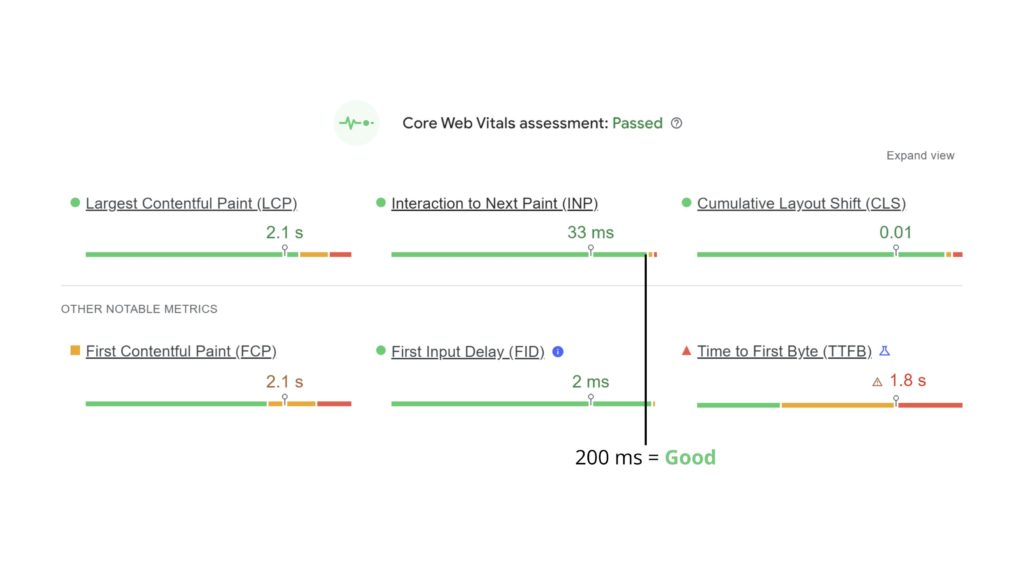Google har kjørt ut en oppdatering og kunngjort en endring i Core Web Vital (CWV) målingene. Lansert 12 Mars, Interaction to Next Paint (INP) tar over stafettpinnen fra det kjente First Input Delay (FID), som en nyttig målestokk for responsivitet på nett. Man kan ikke annet enn å ønske INP velkommen og sørge for at man forbedrer det man kan i henhold til resultatene som kommer av endringen.
Tidlig i 2020 satte Googles Chrome team spotlighten på Core Web Vitals, og ga oss en samling av kvalitetsmålinger for nettsider. Nå har det kommet en oppdatering, og det er alltid spennende. Denne har som mål om å tilby en bedre vurdering av en nettsides brukeropplevelse. Det er det alt på nett dreier seg om i dag, hvordan reisen på nett kan bli bedre, lettere og raskere. Alle vil komme seg fra A til B fortere enn noengang før. Så hva vil denne endringen si og hva betyr det?
Hva er Interaction to Next Paint (INP)?
Både FID og INP tar for seg hvor responsiv og interaktiv en nettside føles. Nettsider med gode FID- eller INP-scorer beskrives gjerne som «raske» og «lette». Med introduksjonen av INP fokuseres det på tiden det tar fra en interaksjon på nettstedet til neste visuelle oppdatering skjer.
Årsaken bak INPs introduksjon er enkel, det gir et mer presist bilde av brukeropplevelsen over hele linja. Et nettsted som konsekvent sikrer rask og smidig interaksjon anses som overlegent sammenlignet med et som kun gir deg litt av samme følelse ved førsetinntrykket.
Hvordan blir INP kalkulert?
INP beregnes ved å observere alle interaksjoner som utføres på en side. For de fleste nettsteder rapporteres interaksjonen med verst ventetid som INP. Imidlertid, for sider med et stort antall interaksjoner, kan tilfeldige feiler resultere i en interaksjon med uvanlig høy ventetid på et ellers responsivt nettsted. Jo flere interaksjoner, desto mer sannsynlig er dette å skje. For å motvirke dette, og gi et bedre mål på den faktiske responsiviteten for slike sider, ignorerer vi den høyeste interaksjon for hver 50’ende interaksjon. Siden det store flertallet av sideopplevelser ikke har over 50 interaksjoner, rapporterer nettleseren nesten alltid den verste interaksjonen. Det 75. persentilet av alle sidevisninger rapporteres deretter som vanlig, noe som ytterligere fjerner outliers for å gi en verdi som er mer representativ for den generelle brukeropplevelsen.
En interaksjon er en gruppe hendelseshåndterere som utløses under samme logiske brukergeste. For eksempel inkluderer «tap»-interaksjoner på en berøringsskjermenhet flere hendelser, som pointerup, pointerdown og klikk. En interaksjon kan drives av JavaScript, CSS, innebygde nettleserkontroller som skjemaelementer, eller en kombinasjon av disse tingene.
Ventetiden for en interaksjon består av den enkelte lengste varigheten av en gruppe hendelseshåndterere som driver interaksjonen, fra det tidspunktet brukeren starter interaksjonen til øyeblikket neste ramme presenteres med visuell tilbakemelding.
Hva er en god INP-score?
For å sikre at du leverer brukeropplevelser med god responsivitet, er et godt mål å måle det 75. persentilet av sidelastninger registrert i feltet, segmentert på mobile enheter og stasjonære enheter:
- En INP som er lik eller mindre enn 200 millisekunder betyr at siden din har god responsivitet.
- En INP mellom 200 millisekunder og 500 millisekunder betyr at sidens responsivitet trenger forbedring.
- En INP større enn 500 millisekunder betyr at siden din har dårlig responsivitet.

Vi jobber allerede med INP
Her hos Websupporten har vi allerede tatt grep for å omfavne INP, med mål om å sikre at alle nettsteder vi håndterer, lever opp til Googles nye standard. Vi benytter Google Chrome’s Dev-verktøy for å analysere INP-målingene, identifisere og forbedre eventuelle tregheter eller punkter som har fått en påvirkning av oppdateringen, på tvers av nettsidene vi administrerer. Overgangen til INP er for oss, bare en bekreftelse om at vi jobber i riktig retning, og tilpasser oss tiden. CWV er en del av nåtidens nettsider og hvordan de rangerer.

Hvordan sjekker du din nettside og hva kan du gjøre nå?
Endringen fra FID til INP markerer en ny tid for webutviklere og SEO-spesialister, med et fornyet fokus på å forbedre nettsidens interaktivitet og responsivitet. Vi sår klar til å veilede og støtte bedrifter gjennom oppdateringen, men du kan selvsagt begynne å teste deg fremover selv for å finne resultater for din egen nettside. Kopier URL’en din inn på Googles PageSpeed Insights (PSI) side HER. (Så får du opp resultatet.)
Som alltid, anbefaler vi et avslappet forhold til slike målingene. Selv om de er viktige, er de bare en del av det store bildet når det gjelder å forbedre sidens brukeropplevelse. Hold fokuset på å lage gode nettsider, og ikke la målingene styre deg. De er en pekepinn, en veileder for hvilken retning man tar, men å ta vare på hele brukeropplevelsen samtidig, er key. Ta en titt på din INP-score, se etter enkle forbedringer, og fortsett å skap gode opplevelser på nett.

